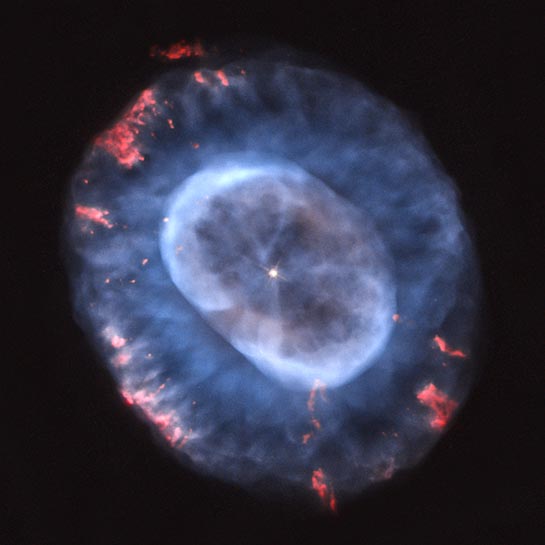
Part of a new Chandra Survey
Planetary Nebula
RA 23h 25m 63.60s Dec +42° 32' 06.00"
Andromeda
About 4,100 light years
8.6
Image is 37 arcsec across. (about 0.73 light year)
May 15, 2012
8 hours 20 min
X-ray (Purple), Optical (Red, Green, Blue)
X-ray: NASA/CXC/RIT/J.Kastner et al.; Optical: NASA/STScI
October 10, 2012
ABOUT THIS IMAGE:
From Wikipedia:
NGC 7662, also known as the Blue Snowball Nebula or Snowball Nebula, is a planetary nebula located in the constellation Andromeda.
The distance to this nebula is not known with any real accuracy. According to the Skalnate Pleso Catalogue (1951) the distance of NGC 7662 is about 1,800 light years, the actual diameter about 20,000 AU. In a more recent survey of the brighter planetaries, C.R.O'Dell (1963) derived a distance of 1,740 parsecs or about 5,600 light years, increasing the actual size to 0.8 light year, or nearly 50,000 AU. It has a faint central star that is variable, with a magnitude range of 12 to 16. The central star is a bluish dwarf with a continuous spectrum and a computed temperature of about 75,000K. The nuclei of the planetary nebulae are among the hottest stars known.
NGC 7662 is a popular planetary nebula for casual observers. A small telescope will reveal a star-like object with slight nebulosity. A 6" telescope with a magnification around 100x will reveal a slightly bluish disk, while telescopes with a primary mirror at least 16" in diameter may reveal slight color and brightness variations in the interior.
From Chandra:
This image is one of the planetary nebulae from the first systematic survey of such objects in the solar neighborhood made with NASA's Chandra X-ray Observatory. X-ray emission from Chandra is colored purple and optical emission from the Hubble Space Telescope is colored red, green and blue. (see rollover image for the x-ray composite)
A
planetary nebula is a phase of stellar evolution that the Sun should experience
several billion years from now. When a star like the Sun uses up all of
the hydrogen in its core, it expands into a red giant, with a radius that
increases by tens to hundreds of times. In this phase, a star sheds most
of its outer layers, eventually leaving behind a hot core that will soon
contract to form a dense white dwarf star. A fast wind emanating from
the hot core rams into the ejected atmosphere, pushes it outward, and
creates the graceful, shell-like filamentary structures seen with optical
telescopes.
The diffuse X-ray emission seen in about 30% of the planetary nebulas
in the new Chandra survey is caused by shock waves as the fast wind collides
with the ejected atmosphere. The new survey data reveal that the optical
images of most planetary nebulas with diffuse X-ray emission display compact
shells with sharp rims, surrounded by fainter halos. All of these compact
shells have observed ages that are less than about 5000 years, which therefore
likely represents the timescale for the strong shock waves to occur.
About half of the planetary nebulas in the study show X-ray point sources
in the center, and all but one of these point sources show high energy
X-rays that may be caused by a companion star, suggesting that a high
frequency of central stars responsible for ejecting planetary nebulas
have companions. Future studies should help clarify the role of double
stars in determining the structure and evolution of planetary nebulas.